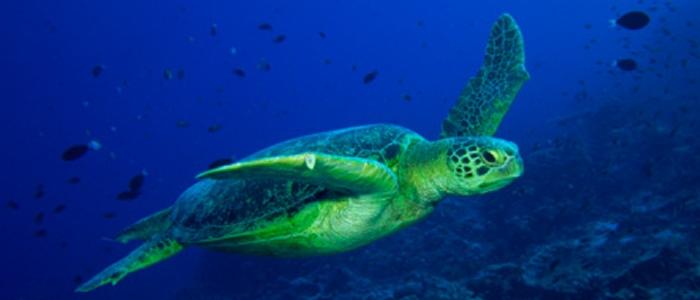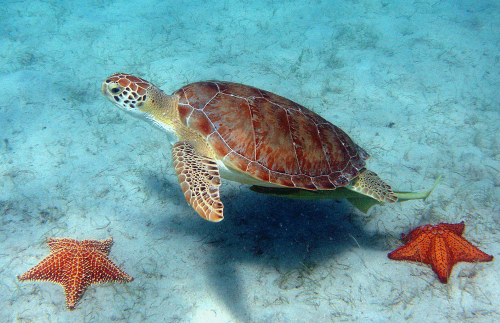
Habitat
Green turtles usually inhabit shallow areas with an abundance of algae and sea grass such as inlets, reefs, and bays (U.S., 2013). They are known to migrate long distances to their breeding grounds where they lay their eggs. These eggs then hatch into juveniles that crawl to the ocean and float on currents (Arkive, 2013).
Greens habitat encompass three different types: high energy beaches, convergence zones in the pelagic habitat, and benthic feeding grounds in relatively shallow, protected waters (Magnuson, 1990). After finding suitable feeding areas, Chelonia mydas are known to sleep in the same location every evening (Lemm, 2006).
They are found in tropical climates and inhabit both the Pacific and Atlantic ocean along with the Indian ocean (Arkive, 2013). The water in the area cannot fall below 20°C or they will look for other feeding grounds (Marinebio, 2012). More specifically, green turtle's main habitats include Galapagos Islands, Austrailia, and Hawaii (Safina, 2006). In the United States, they inhabit the U.S. Virgin Islands, Puerto Rico, and from Texas to Massachusetts (Magnuson, 1990). In Florida, they inhabit rivers and bays grazing for food. Some of these locations include the Indian River, Florida Bay, Homossassa Bay, Crystal River, and Cedar Key (Magnuson, 1990).
Females looking for nesting grounds seek undisturbed and uninhabited locations. Many of these nesting sites are located in the highly populated beaches in Florida. As population increased, the light pollution from the buildings near the beach caused havoc on the female turtles and their young. These lights were found to disorientate hatchlings and residents would find newly hatched turtles in their bushes on the roads where they were killed by cars (Safina, 2006). As a result of this, twenty counties and forty-six municipalities in the area have passed ordinances regulating light usage at night from June through October (Safina, 2006).
Hatchlings and adult female turtles use photic cues on nesting areas to orient themselves with their location and the ocean (Safina, 2006).

Green sea turtles are believed to be able to dive as deep as 400 feet and are known to sometimes hibernate at the bottom for weeks at a time (Safina, 2006). They spend up to 95% of their time underwater, coming up occasionally for a breath of air and then immediately submerge again (Safina, 2006). In one breath, green sea turtles can exchange up to 80% of the air in their lungs, while humans can only exchange up to 10% (Safina, 2006).
Chelonia mydas has been listed as endangered by the International Union of the Conservation of Nature (IUCN) and it is also endangered in southern California and Pacific Mexico by the United States Endangered Species Act (Lemm, 2006). It is also listed in Appendix I of the Convention of International Trade of Endangered Species (CITES), which protects the species from international trade (Lemm, 2006). In Florida prior to the Endangered Species act in the 1970s, there were thought to be only thirty-two nesting sites left (Salfina, 2006).
Chelonia mydas is the primary source of the well-known "turtle soup" and for a time had been almost fished to distinction (Pope, 1971). "Calipee" and "calipash" are two important ingredients in this soup to obtain the gelatinous consistency that it is famous for (Conant, 1975).
Throughout Southeast Asia, green turtle consumption is estimated at approximately 100,000 per year (Safina, 2006). On the Indonesian island of Bali, the world's largest sea turtle slaughter takes place with as many as 20,000 green sea turtles brought into market and sold annually (Safina, 2006). Eating turtle signifies wealth and prestige in these locations and is engrained in their culture and religion (Safina, 2006).
<< Classification Home Nutrition >>